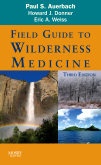|
|
|
| |
 |
|
|

|
 推薦指數:
推薦指數:





|
|
- 內容介紹
|
Field Guide to Wilderness Medicine, 3rd Edition
By Paul S. Auerbach, MD, MS, FACEP, FAWM, Howard J. Donner, MD and Eric A. Weiss, MD
944 pages 264 ills
Trim size 4 3/4 X 7 3/4 in
Copyright 2008
Description
Completely revised and updated, the new edition of this portable guide offers fast-access solutions to all of the medical situations that can occur in non-traditional settings. Based on Dr. Auerbach’s critically acclaimed text Wilderness Medicine, 5th Edition, this handbook is packed with how-to step-by-step explanations and the latest practical advice on diagnosis and treatment—emphasizing ways of improvising care with whatever materials you have available. It’s small enough to be carried in a car’s glove compartment or in your backpack—yet detailed enough to cover the clinical presentation and treatment of a full range of emergencies!
Key Features
Offers appendices that address everything from environment-specific situations to lists of essential supplies, medicines, and many additional topics of care, enabling you to meet a full-range of emergency situations with the utmost effectiveness.
Includes line drawings—along with a section of color plates—that aid in the identification of skin rashes, plants, snakes, insects, and more.
Provides Signs and Symptoms and Treatment sections in most chapters—combined with bulleted lists and text boxes—that facilitate quick and easy retrieval of information.
Presents full chapter coverage of both animal attacks and zoonoses for handling life-threatening situations.
Features peerless guidance in a portable format for consultation anywhere from the office setting to the open outdoors.
New to this Edition
Features a new appendix on jungle travel and survival, and new chapters on forest fires, bandaging and taping techniques, mental health, hydration and dehydration, malaria—and more—equipping you to handle any emergency you might encounter in the wilderness.
Includes more tips for improvisational care (eg, how to make a rigid litter using skis, poles, snowshoes, canoe paddles, or tree branches) to help you respond to wilderness and nontraditional emergencies with the materials that you have on hand.
Presents thorough revisions to all previously existing chapters—ensuring that you have the latest knowledge at your fingertips
|
|
|

